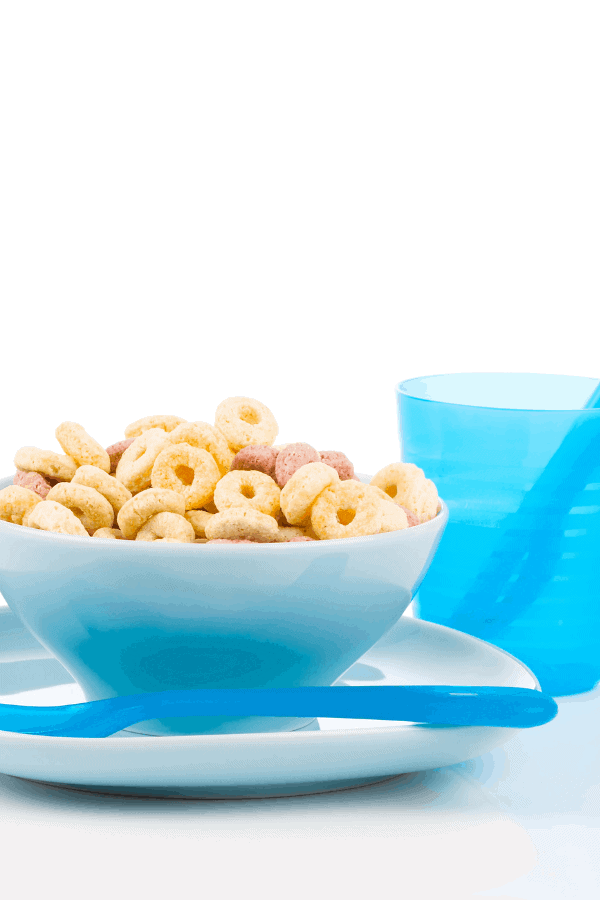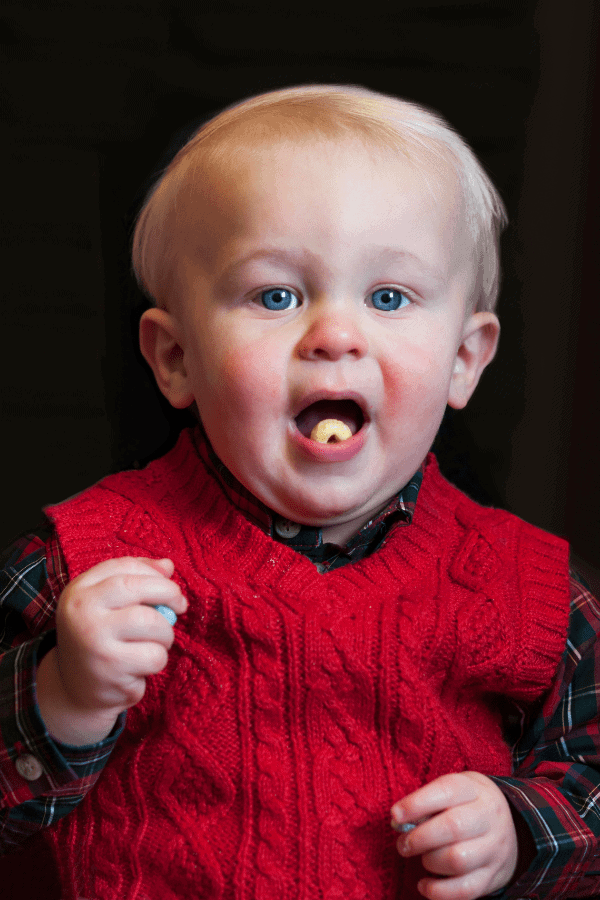
Between the ages of 4 and 6 months, you can begin to wean your baby off milk and onto more solid foods; at the clearance of your child’s healthcare provider or pediatrician.
This is an exciting time for any parent. Introducing your baby to new foods is fun and enriching, but it also comes with its fair share of frustrations.
For example, foods need to be introduced gradually. At the beginning, you need to keep it simple.
Some foods simply aren’t safe for your baby to eat yet. It’s good to get the balance between safe, easy to eat foods that are also nutritious.
Waiting too long to feed your baby solid foods isn’t good and may cause allergy and eating issues further down to the line.
You need to pick the perfect time to introduce a new food, which adds to the pressure on parents.
Cereals are a healthy food for a baby, as well as easy to prepare.
However, the obvious problem raises its head – choking hazards. While a bowl of Cheerios or melty puffs is a quick breakfast for a stressed parent to whip up, is it safe to give to your baby? Let’s find out.
Please note – I am not a certified Dietitian or Nutritionist, this information should not be taken as medical advice and as with all new foods, you should discuss the introduction of new foods with your child’s doctor. please read my disclaimer for more information.

As an Amazon Associate I earn from qualifying purchases. The links below may be affiliate links. Please read my disclosure policy for more information.
When Can Babies Eat Cheerios (or other cereals)?
Cheerios are a fun and delicious snack for kids, and easy for a parent to serve.
However, the ideal time to start giving your baby Cheerios is around the 9 to 12-month mark.
The danger with Cheerios is that they don’t dissolve easily. Some snacks, like melty puffs or graham crackers, dissolve quickly in your baby’s mouth.
Cheerios don’t. This means that your baby will ineffectually try to chew with what few teeth they have, and then swallow long before the Cheerio is ready to be swallowed.
As you can imagine, this is a recipe for a choking baby and a panicking parent.
Cheerios are very different to fruit puree and smooth baby food. It’s good to make sure your baby is comfortable with eating easier foods before you move on to cereals like Cheerios.
Can you Give a Baby Honey Nut Cheerios?
Cheerios are fine – presuming they’re plain. Honey nut Cheerios should be avoided until your baby is at least a year old.
Why is this so important?
Babies and infants should never be given honey products. The reason for this is that honey can sometimes contain botulism spores.
Before you throw away your jar of honey in a panic, don’t worry. These spores don’t affect adults or children, but they can pose a serious threat to infants and babies.
Babies don’t have a sufficiently developed immune system to deal with these otherwise harmless spores.
Infant botulism is a life-threatening condition, rapidly spreading toxins throughout your baby’s body.
This can lead to paralysis, weakening the baby’s muscles until they can no longer even breathe.
While honey is the primary source of danger, other products containing honey, such as honey nut Cheerios, should also be avoided.
While the risk is much lower, it’s not a chance that any good parent would want to take.

What Cereals are Best for my Baby?
At the beginning, it’s best to stick to single-grain cereals for your baby.
There are specially designed baby cereals available in supermarkets, which can make a nutritious and easily prepared snack for your baby.
Here are a couple of handy cereals that you can serve to your infant – that won’t break the bank:
Oatmeal:
Good old-fashioned oatmeal can be a perfect food for you baby. Oats are a great source of fiber, ideal for kick-starting your baby’s gut.
However, you will need to run the oats through a blender before serving it to your baby. This should crush the oats up into a fine mixture that won’t clump or leave chunks of oat in your baby’s porridge.
You can also mix pureed fruits into the oatmeal, once your baby is able to eat mixtures of food. A few spoons of pureed strawberry or banana can add a sweet kick to the porridge, as well as adding valuable vitamins
If you’re on a budget, oatmeal is much cheaper than specialized baby cereal. What’s more, parents can eat it, too!

Weetabix/Oatibix (or your local alternative):
This is another great cereal that you can give your baby from 6 months onwards. However, it will require some preparation.
Add plenty of milk (if you’re just starting your baby on solids, you could try adding breast milk) and make sure the Weetabix is well mashed up.
The milk will make it soft and smooth, almost like porridge. This will make it much easier for your baby to eat.
However, the texture will still be a little lumpy. Always keep a close eye on your baby while they eat.
Just like oatmeal or porridge, you can add extras to the Weetabix as soon as your baby is ready. Pureed fruit is always a good option.
When your baby is ready to eat more whole foods, you can add mandarin segments, other fruits, or baby-friendly yogurt.

Ready Brek (or your local alternative):
It’s hard to go wrong with simple porridge. However, do be careful.
While porridge tend to be reasonably smooth, they can have a somewhat lumpy texture.
Especially if your baby is new to the business of eating solid foods, keep a close eye on them while they eat.
If in doubt, put the mixture in a blender or mash with a fork before you serve the cereal to your baby.
Warnings:
However, there is a downside to serving your baby “adult” cereals. These cereals naturally have adult-sized portions of salt and sugar, and these can be too much for your baby.
Check the salt and sugar content before serving to your child.
In the case of Weetabix, it’s not recommended to serve more than one wheat/oat biscuit at a time. You shouldn’t add any extra sugar to your baby’s cereal.
How Can I Tell if my Baby is Ready to Eat Cheerios?
Perhaps now you’re too afraid to feed your baby anything new! You might worry about allergies (gluten, dairy, and strawberry allergies, for example), or worry about giving your baby a new food too soon.
Smooth foods like oatmeal, porridge, baby food, pureed fruit, and well-mashed Weetabix may be suitable for your baby right from the beginning, but how can you tell if you baby is ready for more difficult foods – like Cheerios?
Here are few signs to look out for:
- Is your baby aged between 9 to 12 months old?
- Do they “munch” food, working their jaw up and down?
- Are they comfortable eating other foods?
- Can they pick up the piece of cereal with their thumb and index finger?
If you answered yes to all of these questions, there’s a good chance that you can safely try your baby with Cheerios or another kind of cereal puff.

Choking Hazards
This is every parent’s worst fear. You serve them what you think is a perfectly suitable finger food, one your baby has eaten before, and they begin to cough and splutter. Even the idea is terrifying and upsetting.
Foods like melty puffs may seem to be the perfect snack for babies, however there are hidden dangers. While they are crunchy and dissolve quickly in a baby’s mouth, they change when exposed to the air.
Puffs left out for too long will become squishy and lose their ability to dissolve so quickly. This means that when your baby reaches for another melty puff, they swallow before the puff is ready to be swallowed. That is when choking can occur.
Cheerios can be even more of a choking hazard. While fresh puffs dissolve quickly in a baby’s mouth, Cheerios don’t. They require a bit of chewing, which is fine for an adult, but problematic for a baby.
At this stage of your baby’s development, they go through the action of chewing, but essentially are just using their gums to squish the food. This is why tough, very crunchy, or sharp foods need to be avoided.
There’s also the danger of your baby putting too large a handful in their mouth. If your baby has a habit of doing this, it might be a good idea to only put out a few Cheerios or puffs at a time
Introducing your baby to new foods is a perfectly normal and healthy part of their development. While you shouldn’t introduce new foods too soon, delaying isn’t good for your baby, either.
It’s important to remember that, at this age, there are no perfectly safe foods for a baby. Their windpipes are approximately the width of a straw, and food that can’t be broken down to fit through a straw will likely cause choking.
As a parent, it’s your responsibility to supervise your baby while they eat. This means that if choking does occur, you’ll be on hand to take action.
Always make sure your baby is sitting upright in a secure position when they eat. Accidents happen and bringing up a baby is fraught with risk. But with a little common sense and genuine care and love, you can do it!
